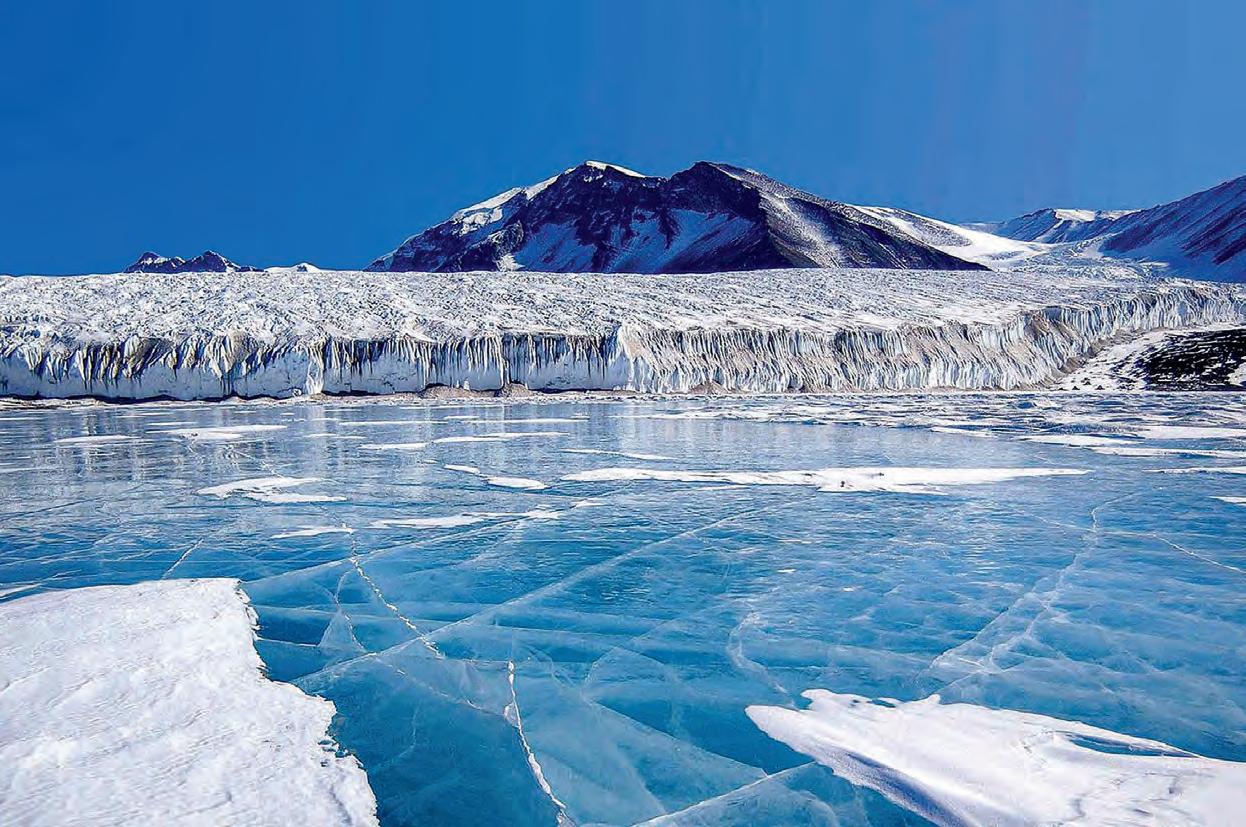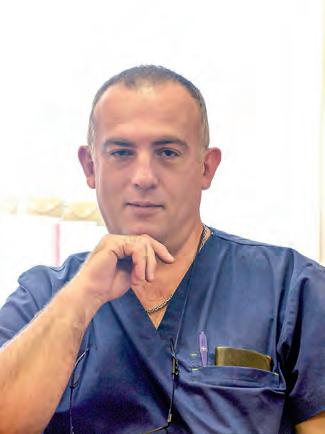
8 minute read
Wintering in Antarctica is a special case
The 13th Belarusian Antarctic Expedition was solemnly launched at the NASB
Advertisement
tThis year ten participants will go to the ice continent: both spe- Belarusian Antarctic Station. For two years, documentation was cialists who have already visited Antarctica (five people) and first- being developed and preparatory work was in progress. The first timers. The expedition members will have hard work to do in order facility appeared in 2015, it was a communication and navigation to boost the construction of their own house in Antarctica — Be- management module. larusian Antarctic station “Vechernyaya Mountain”, as well as to do scientific research as part of the state program of Antarctic studies.
At the end of October, the members of the 13th Belarusian Antarctic Expedition left for St. Petersburg. Expeditionary cargoes were sent there as well. From St. Petersburg on board a Russian vessel the Belarusian polar explorers went to Antarctica. From December to mid-February, i.e. 2.5 months, scientific research and work on the deployment of the outpatient surgical module of the station will be conducted at the South Pole. The return of Belarusian polar explorers to their home country is planned in the first half of March.
The day before the permanent head of all the Belarusian Antarctic expeditions Alexey Gaydashov told a BelTA correspondent about the plans to build infrastructure, scientific research, princi- delegation of Belarusian polar explorers ples of selection and life of the polar explorers, as well as about the plans to do all-year research. In an abridged version we give the And today the first stage of the station construction allows to most interesting questions and answers. house up to 11–12 people of the expedition members. Each has their own living room, albeit small, but cozy, with a heating and from Spartan conditions — to comfort ventilation system. There is a separate sanitary-hygienic module. There are modern scientific laboratories in such areas as atmos— Alexey Alexandrovich, how did Belarus start to explore pheric physics and biology. There is a hydrometeorological bu-
Antarctica? What has been achieved in the past years? reau: its instrumentation allows remote measurement of the main — Our country acceded to the Antarctic Treaty in 2006. For parameters of the Antarctic natural environment, i.e. wind speed a long time after that we worked in the field environment. The and direction, relative humidity and air temperature. And all data
Russian side granted to use free of charge several structures that is immediately processed and sent to the main land. This is imporhad survived since Soviet Antarctic expeditions. They were rather tant, among other things, for servicing flights of Antarctic aviation dilapidated, with cracks, old broken furniture, it was dark, cold and maritime navigation. and damp there. It was impossible to heat the room well: the diesel — And what do the main structures of the Belarusian Antarcgenerators were weak. Sanitary conditions were very bad. We used tic Station look like now? to wash with water from the kettle, to cook on a small gas cooker — The service and residential module for communication and with two burners which had small gas cylinders. As for our work, navigation management, which was built first, houses a meteorowe mainly took measurements, collected samples and specimens logical bureau, navigation equipment, communication equipment to bring them to Belarus because we could not even process them for both Antarctica and the Mainland, aviation and ships. The secon site due to the lack of scientific laboratories. ond facility is an eight-section laboratory and residential module,
Despite the fact that we had to work in harsh conditions for which we completed during the 12th expedition. There are scientifa long time, our zeal didn’t burn out. We went forward step by ic laboratories, living quarters, a technological module for controlstep. In 2013, the Government, the National Academy of Sciences ling electricity, a sanitary section with showers, washing machines, and the Ministry of Natural Resources, in consultation with the a section-sauna with a rest room, an outpatient clinic with modern
Ministry of Finance, approved a plan for the construction of the control and diagnostic, physiotherapeutic equipment. Another sec-
tion is an operating and surgical unit equipped according to the most modern medical care requirements. The equipment makes it possible to perform complex surgical interventions if necessary.
Unfortunately, for logistical reasons, medical structures did not arrive until late in the season. We unloaded them and had to leave for the mainland. This is why the medical facility is still mothballed. The task of the next expedition is to deploy it, install, check and commission the equipment.
our own “house of culture”
— Are there plans to continue construction in the coming years?
— Yes, the formation of the Belarusian Antarctic station cannot be considered complete. The plans include the next stage of the five-year state programme. Further infrastructure development is envisaged. For example, we need a community room and a cookroom — not only for cooking and eating, but also for creating a favourable socio-psychological climate in the team. People can gather there, spend an evening together, talk and relax. In Antarctic conditions, it will be not only a kitchen and dining room, but also a kind of cultural centre. There will be a library, a video library and board games.
In the next five years we should have an geophysical observatory which will house a laboratory and accommodation for two employees. Geophysical equipment of the observatory, including a seismograph, will monitor underground fluctuations in the Antarctic and beyond.
— This season the Belarusian station was visited by the international inspection of the Antarctic Treaty. How did foreign experts evaluate the work of the Belarusian polar explorers?
— The Inspectorate studied safety, ecology, energy supply, water supply, safety of vehicles, communications, including satellite communications, and organization of scientific research. A comprehensive, unbiased and objective inspection was carried out. Based on the results of the inspection we were told that the Belarusian Antarctic station is the best of 12 inspected by this group in the season 2019–2020. The inspectors emphasized the high degree of environmental safety, processability, wide use of alternative energy sources, energy-efficient equipment, safe and efficient life support equipment.
The scientific component of the expedition received very high reviews: the instrumentation base, the complexes, the types of scientific programmes and observations implemented by the Belarusian Antarctic Expedition.
The inspectors talked to each polar explorer separately. Then, sharing their impressions, they stressed that the station employs very qualified personnel and has an exemplary discipline.
— Under the state program Belarusian polar explorers work in Antarctica only during the summer season. When are you planning to stay for winter?
— In the next year or two the transition to wintering activities is not considered for objective reasons until the global transport and logistics situation has stabilized. It would be reckless to stay overwintering now without knowing what will happen in six months or a year, how to evacuate people, how to provide them, how to change the composition of the expedition. We have decided to conduct only seasonal expeditions for the time being.
It is indicative that every year there are expedition-members who have already been to the Antarctic and want to go again. For example, there will be five experienced polar explorers on the 13th expedition. This is very important. It is difficult to teach a beginner: he may be a super-professional on the main land, but in Antarctica there are a lot of nuances, difficulties, special conditions for living. You have to work individually with everyone. All the polar explorers who participated in the Belarusian Antarctic expeditions, are worth their weight in gold, because they know where they are going to and why, how to behave and work there.
— Are you going to take only experienced polar explorers on a winter expedition?
— There are always first-timers. 50% of specialists with experience in the Antarctic is, as a rule, the optimal number for the whole team to work steadily. The winter expedition does not include an extended team, as some types of scientific observations are not conducted during the Antarctic winter. In the future we are planning that 14–15 people will work at the Belarusian Antarctic Station during the period of seasonal work, and 10–11 people will stay for wintering.
Overwintering is a special case. Eight months a year no one will be able to help in the Antarctic: neither a plane nor a ship will come. During a seasonal expedition, in the event of some force majeure, it is possible to evacuate a patient, to deliver spare parts if something goes wrong. But when wintering begins, we can only count on what we have brought and the people around us. For the winter period, a stable team-composition is required, which is compact and minimal in terms of efficiency and safety. These are life support technicians and scientific staff for year-round scientific programmes.
Over 15 years, we have gained experience and staff. But you have to understand that never important projects and facilities are put into operation immediately for wide use, whether it be metro stations or space flights. At first, everything is repeatedly worked out and tested. This is also in our case. First, a pilot wintering session should be held with the participation of predominantly technical specialists. Let there be only one or two scientists, but there must be technicians — each in his or her own area. During this isolation all systems must be checked and it must be ensured that everything is safe. And if something is wrong, they have to correct the mistakes when they come back. Only then can we talk about starting a continuous cycle of year-round wintering in Antarctica. By Nadezhda Nikolayeva








